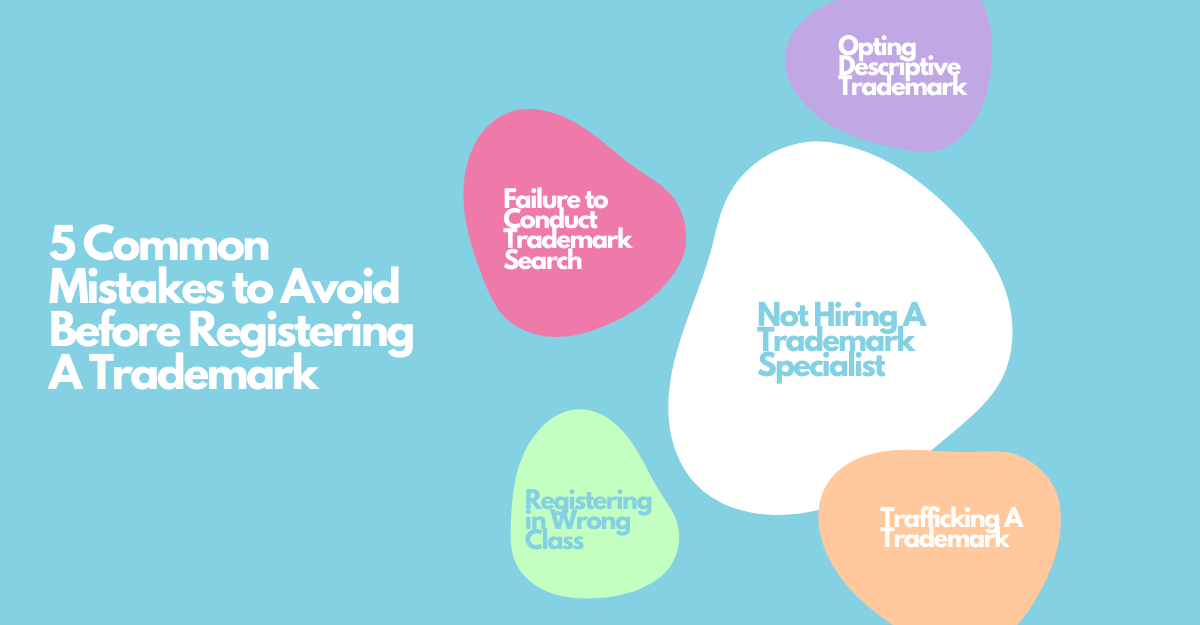Trademarks are marks or signs which can be graphically represented and capable of identifying the products and services of one brand from the other. When any new enterprise wants to start with a new business or is looking to expand an existing one, they have to register the brand under which they will be functioning as a trademark. For the trademark registration, the entity should first deliberate over specific points to confirm that the mark for which they are applying for registration does not get rejected or affect the quality of the brand which they are trying to promote. Keeping the same in mind, when opting for a trademark and using it in trade, five common mistakes to be avoided are as follows.
-
Failure to Conduct A Preliminary Search –
Any company before adopting a trademark or a company name should primarily conduct a preliminary trademark search in its domestic trademark registry. If the company has the intention of expanding the business overseas, then they should perform a primary search under the WIPO GLOBAL BRAND DATABASE, along with that they can also perform a basic Google search as well. The reason why trademark searches are paramount because if a company adopts a trademark that is already in use by another entity, the applicant company might put itself in a position wherein they might have to defend themselves in a trademark litigation suit. This scenario could lead to them having to dissuade themselves from using that particular mark, which in turn could result in them losing out on any goodwill which the brand would have acquired.
-
Opting for a Generic / Descriptive Trademark –
Generic wordmarks being used as trademarks find it very arduous to receive trademark protection. They usually are words or symbols which showcases what that particular brand is offering the kind of product or service. These are the words commonly used in the market for products or services for which the mark is to be used (e.g., SMOOTH for skincare products).
Whereas, descriptive words are trademarks where they identify any of the goods or services for which registration is being sought (e.g., GREEN MARKET for the selling of vegetables).
This is very tempting that elements indicating the quality, feature, function, or intent of the goods or services are included in the brand name. But one should remember that the local trademark office can reject a trademark that contains these products.
They end up being descriptive of the product or services which are being rendered by the brand. For example, a bakery business trying to register “CUPCAKES” as their trademark – it will one be generic along with being descriptive of the services and products they are offering.
Also, in the case of trademarks, sometimes certain registered trademarks end up becoming so synonymous with the brand and the product or service, which they are offering that it takes a generic turn. This concept is referred to as the genericization of a trademark. For this reason alone, a trademark should not be used as a noun or a verb and instead be used as an adjective or an adverb. A few examples of a trademark becoming generic are Xerox and Aspirin.
-
Registration In The Wrong Class
At times entities looking to register their trademark fail to register their prospective mark in the correct classes of goods or services. This selection becomes an issue because the company will lose out on protection in the relevant class wherein, they are functioning in. The most commonly followed distinction between goods and services is a NICE classification. The repercussions could be that once the entity has registered the mark in the wrong class, then this omission on their part cannot be rectified. They will have to file for a new application. This could prove to be unfavorable to the entities since it could result in unnecessary wastage of time and capital.
-
Trafficking A Trademark –
In some instances, an individual or a company might try and traffic their prospective trademark. In this case, what they usually do is that they register the trademark in many different classes as per the NICE Classifications. When they do not have any intention of using the same in that particular class, this is done solely to stop others from using that specific trademark. This results in the trademark being exclusive to that particular individual or that company in classes where they do not intend to do business. The United States Court of Law has followed stringent principles when it comes to companies trying to do such acts.
-
Not Hiring A Trade Mark Specialist –
Markings are crucial for any company, and, when appropriately treated, they can have a devastating effect. Before a procedure (geographical names, surnames, prohibited signals, geographical indications, etc.), various factors that are not even listed in this article will have to be considered. While the trademark laws and procedures in each country include substantial stroke similarities, local regulation and practice differ from jurisdiction to jurisdiction. Thus, even if a trademark has been registered successfully in your country, but you want to make it international, the assistance of a local expert is always recommended.
Therefore as a matter of proper rule of thumb, any new trademark registrations need proper preliminary research done to avoid conflict with an existing mark, and since most of the business enterprises lack the relevant knowledge with regards to the nitty-gritty about trademark registration outside counsel help from a trademark specialist is advised.




